Major floods can wreak havoc on communities, causing significant damage to property, infrastructure, and even loss of lives. Understanding how to survive a major flood disaster is of paramount importance. In this article, we will explore the steps and strategies individuals and communities can take to prepare for, endure, and recover from such catastrophic events.
1. Introduction
Understanding the Threat of Major Floods
Major floods occur as a result of various factors, including heavy rainfall, overflowing rivers, storm surges, and even dam failures. These events can lead to rapid and widespread flooding, posing a severe threat to those in their path. To survive a major flood disaster, one must be prepared for the worst-case scenario.
2. Preparing for a Flood
Early Warning Systems
Early warning systems play a critical role in flood preparedness. Government agencies and meteorological organizations use advanced technology to monitor weather patterns and water levels, providing timely alerts to residents in flood-prone areas.
Evacuation Planning
Planning ahead is crucial. Residents in flood-prone zones should have a clear evacuation plan in place. This plan should include designated evacuation routes and assembly points.
Emergency Supplies
Stocking up on emergency supplies is essential. This includes non-perishable food, clean water, first aid kits, flashlights, and essential medications. Having these supplies readily available can make a significant difference in a crisis.
3. During the Flood
Evacuation Procedures
When authorities issue evacuation orders, it's vital to follow them promptly. Do not underestimate the power of floodwaters; they can be deadly. Leave your belongings behind if necessary, and focus on getting to safety.
Safety Precautions
During a flood, avoid walking or driving through floodwaters. Even seemingly shallow water can have strong currents that can sweep you away. Stay on high ground and out of harm's way.
Communication Strategies
Maintaining communication during a flood is challenging but crucial. Keep a battery-operated radio handy for updates. Use your smartphone sparingly to conserve battery life and communicate with loved ones.
4. After the Flood
Returning Home Safely
Returning home after a flood can be overwhelming. Ensure that authorities have declared it safe to return before doing so. Be cautious of debris and contaminated water.
Dealing with Damages
Assess the damage to your property and document it for insurance claims. Be prepared for a lengthy recovery process, and seek professional assistance if needed.
Seeking Help and Support
Don't hesitate to reach out for help. Government agencies, relief organizations, and community support groups can provide assistance with food, shelter, and emotional support.
5. Lessons from Past Disasters
Case Studies
Learning from past flood disasters is crucial. We can gain valuable insights from studying how communities have coped with and recovered from similar events.
6. Government's Role
Disaster Preparedness Initiatives
Governments play a vital role in flood preparedness. Investment in infrastructure, disaster response, and public education is essential to minimize the impact of major floods.
Relief and Recovery Efforts
Governments also provide critical relief and recovery assistance to affected communities. Understanding the available resources is key to rebuilding after a flood.
7. Community Resilience
The Importance of Community Bonding
Communities that come together in times of crisis are more resilient. Building strong community bonds can provide emotional and practical support during and after a flood disaster.
Mutual Aid Networks
Establishing mutual aid networks can help neighbors assist each other during emergencies, ensuring that everyone's needs are met.
8. Flood Insurance
Understanding Coverage
Flood insurance is often a lifesaver in the aftermath of a flood disaster. Understand your policy's coverage and ensure you have adequate protection.
Importance of Flood Insurance
We delve deeper into the importance of flood insurance and why every homeowner in a flood-prone area should consider it.
9. Technology and Flood Preparedness
Advancements in Flood Prediction
Technological advancements have improved our ability to predict and monitor floods. We explore the latest innovations in flood prediction and management.
GIS Mapping and Flood Management
Geographic Information Systems (GIS) mapping plays a crucial role in flood management. Learn how GIS is used to mitigate flood risks.
10. Climate Change and Flood Risk
Impact of Climate Change
Climate change is exacerbating flood risks. Understand how shifts in climate patterns are increasing the frequency and severity of major floods.
Mitigation Strategies
Explore the strategies and policies needed to mitigate the impact of climate change on flood disasters.
11. Conclusion
In conclusion, surviving a major flood disaster requires comprehensive preparedness, swift action during the event, and resilience during the recovery phase. By understanding the threat, planning ahead, and relying on the support of the community and government, individuals and communities can increase their chances of surviving and thriving in the face of a major flood disaster.
Frequently Asked Questions (FAQs)
-
What should I do if I receive a flood evacuation order?
- Follow the order immediately. Evacuation orders are issued to keep you safe. Leave your belongings and focus on your safety.
-
Is flood insurance really necessary?
- Yes, especially if you live in a flood-prone area. Flood insurance can provide essential financial protection in the event of flood damage.
-
How can I help my community prepare for floods?
- Get involved in community preparedness initiatives and consider establishing a mutual aid network to support your neighbors during emergencies.
-
Are there any apps or tools for flood monitoring and prediction?
- Yes, there are several apps and tools available that provide real-time flood information and alerts. Stay informed and use these resources to stay safe.
-
What is the role of climate change in increasing flood risks?
- Climate change is leading to more extreme weather events, including heavy rainfall, which increases the likelihood of major floods. Mitigating climate change is essential to reducing these risks.

